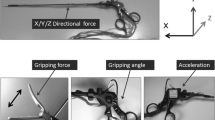Abstract
In order to train microsurgeons, instead of using living animals, a realistic non-living model has been used. The front legs of pigs are suitable for training in microsurgical techniques because the microscopic and gross anatomy of the pig's front leg corresponds well to that of the human upper extremitiy.
Similar content being viewed by others
References
Awwad AM (1984) A training card for microsurgery. J Microsurg 5:160
Ayoubi S, Ward P, Naik S, Sankaran M (1992) The use of placenta in microvascular exercise. Neurosurgery 30:252–254
Freys SM, Koob E (1988) Ausbildung und Training in der Mikrochirurgie ohne Versuche am lebenden Tier. Handchirurgie 20:11–16
Goldstein M (1979) Use of fresh human placenta for microsurgical training. J Microsurg 1:70–71
Gould SH (1986) The role of the microsurgical laboratory in orthopedic training programs. Orthopedics 6:881–882
Govila A (1979) A simple model on which to practice microsurgical technique: a fresh chicken. Br J Plast Surg 34:486–487
Green CJ (1990) Organisation of a microvascular laboratory. Br J Plast Surg 43:640–641
Guler MM, Rao GS (1990) Canniesburn “ever-ready” model to practise microsurgery. Br J Plast Surg 43:381–382
Kaufmann T, Hurwitz DJ, Ballantyne DL (1984) The foliage leaf in microvascular surgery. J Microsurg 5:57–58
Leconte D (1988) Utilisation du placenta en microchirurgie vasculaire experimentale. J Chir 25:53
Lee S, Coppersmith WJ (1983) A microvascular surgical practice disc for beginners. J Microsurg 4:67–69
Li PS, Schlegel PN, Goldstein M (1992) Use of silicone medical grade tubing for microsurgical vasovasostomy training. Urology 39:556–557
McGregor JC (1980) The use of placenta for microsurgical vascular practice. JR Coll Surg Edinb25:233
McGregor JC, Wyllie FJ, Grigor KM (1983) Some anatomical observations on the human placenta as applied to microsvascular surgical practice. Br J Plast Surg 36:387–391
Oelsner G, Boeckx W, Verhoeven H, Koninckx P, Brosens I (1985) The effect of training in microsurgery. Am J Obstet Gynecol 152:1054–1058
Steffens K, Hong G, Koob E (1992) Ein realitätsnahes Übun-gsmodell zur Erlernung der mikroneuralen Chirurgie ohne Experimente am lebenden Tier. Handchir Mikrochir Plast Chir 23:310–314
Steffens K, Koob E, Hong G (1992) Training in basic microsurgical techniques without experiments involving animals. Arch Orthop Trauma Surg 111:198–203
Sucur D, Konstantinovic P, Potrarcic Z (1981) Fresh chicken leg: an experimental model for the microsurgical beginner. Br J Plast Surg 34:488–489
Waterhouse N, Moss ALH, Townsend PLG (1985) The development of a dynamic model for microvascular research and practice using human placenta: a preliminary report. Br J Plast Surg 38:389–393
Author information
Authors and Affiliations
Rights and permissions
About this article
Cite this article
Steffens, K., Witthaut, J. & Koob, E. Microsurgical training using pig legs. Eur J Plast Surg 19, 42–44 (1996). https://doi.org/10.1007/BF00209793
Issue Date:
DOI: https://doi.org/10.1007/BF00209793




